Melanopsin Contribution to Pupillary Light Reflex and Brightness Perception Based on a 65-Inch Four-Primary Projected Display
Abstract
:1. Introduction
2. Materials and Methods
2.1. Apparatus
2.2. Stimuli
2.3. Experimental Procedure and Setup
2.4. Participants
3. Results
3.1. PLR
3.1.1. Effect of MEL-Level
3.1.2. Effect of Melanopic EDL
3.2. Brightness Perception
4. Discussion
5. Conclusions
Author Contributions
Funding
Institutional Review Board Statement
Informed Consent Statement
Data Availability Statement
Acknowledgments
Conflicts of Interest
References
- Lucas, R.J.; Douglas, R.H.; Foster, R.G. Characterization of an ocular photopigment capable of driving pupillary constriction in mice. Nat. Neurosci. 2001, 4, 621–626. [Google Scholar] [CrossRef] [PubMed]
- Lucas, R.J.; Peirson, S.N.; Berson, D.M.; Brown, T.M.; Cooper, H.M.; Czeisler, C.A.; Figueiro, M.G.; Gamlin, P.D.; Lockley, S.W.; O’Hagan, J.B.; et al. Measuring and using light in the melanopsin age. Trends Neurosci. 2014, 37, 1–9. [Google Scholar] [CrossRef] [PubMed]
- Allen, A.E.; Martial, F.P.; Lucas, R.J. Form vision from melanopsin in humans. Nat. Commun. 2019, 10, 2274. [Google Scholar] [CrossRef] [PubMed]
- Dacey, D.M.; Liao, H.-W.; Peterson, B.B.; Robinson, F.R.; Smith, V.C.; Pokorny, J.; Yau, K.-W.; Gamlin, P.D. Melanopsin-expressing ganglion cells in primate retina signal colour and irradiance and project to the lgn. Nature 2005, 433, 749–754. [Google Scholar] [CrossRef] [PubMed]
- Brown, T.M.; Tsujimura, S.-i.; Allen, A.E.; Wynne, J.; Bedford, R.; Vickery, G.; Vugler, A.; Lucas, R.J. Melanopsin-based brightness discrimination in mice and humans. Curr. Biol. 2012, 22, 1134–1141. [Google Scholar] [CrossRef]
- Gooley, J.J.; Lu, J.; Fischer, D.; Saper, C.B. Broad role for melanopsin in nonvisual photoreception. J. Neurosci. 2003, 23, 7093–7106. [Google Scholar] [CrossRef]
- Spitschan, M. Photoreceptor inputs to pupil control. J. Vis. 2019, 19, 5. [Google Scholar] [CrossRef]
- Gooley, J.J.; Ivan Ho, M.; St Hilaire, M.A.; Yeo, S.-C.; Chua, E.C.-P.; van Reen, E.; Hanley, C.J.; Hull, J.T.; Czeisler, C.A.; Lockley, S.W. Melanopsin and rod-cone photoreceptors play different roles in mediating pupillary light responses during exposure to continuous light in humans. J. Neurosci. 2012, 32, 14242–14253. [Google Scholar] [CrossRef] [PubMed]
- Douglas, R.H. The pupillary light responses of animals; a review of their distribution, dynamics, mechanisms and functions. Prog. Retin. Eye Res. 2018, 66, 17–48. [Google Scholar] [CrossRef] [PubMed]
- McDougal, D.H.; Gamlin, P.D. The influence of intrinsically-photosensitive retinal ganglion cells on the spectral sensitivity and response dynamics of the human pupillary light reflex. Vis. Res. 2010, 50, 72–87. [Google Scholar] [CrossRef] [PubMed]
- Besenecker, U.C.; Bullough, J.D.; Radetsky, L.C. Spectral sensitivity and scene brightness at low to moderate photopic light levels. Light. Res. Technol. 2016, 48, 676–688. [Google Scholar] [CrossRef]
- Adhikari, P.; Zele, A.J.; Feigl, B. The post-illumination pupil response (pipr). Investig. Ophthalmol. Vis. Sci. 2015, 56, 3838–3849. [Google Scholar] [CrossRef]
- Herbst, K.; Sander, B.; Milea, D.; Lund-Andersen, H.; Kawasaki, A. Test–retest repeatability of the pupil light response to blue and red light stimuli in normal human eyes using a novel pupillometer. Front. Neurol. 2011, 2, 10. [Google Scholar] [CrossRef]
- Adhikari, P.; Feigl, B.; Zele, A.J. Rhodopsin and melanopsin contributions to the early redilation phase of the post-illumination pupil response (pipr). PLoS ONE 2016, 11, e0161175. [Google Scholar] [CrossRef] [PubMed]
- Park, J.C.; Moura, A.L.; Raza, A.S.; Rhee, D.W.; Kardon, R.H.; Hood, D.C. Toward a clinical protocol for assessing rod, cone, and melanopsin contributions to the human pupil response. Investig. Ophthalmol. Vis. Sci. 2011, 52, 6624–6635. [Google Scholar] [CrossRef] [PubMed]
- Young, R.S.L.; Kimura, E. Pupillary correlates of light-evoked melanopsin activity in humans. Vis. Res. 2008, 48, 862–871. [Google Scholar] [CrossRef]
- Joyce, D.S.; Feigl, B.; Cao, D.; Zele, A.J. Temporal characteristics of melanopsin inputs to the human pupil light reflex. Vis. Res. 2015, 107, 58–66. [Google Scholar] [CrossRef] [PubMed]
- Zele, A.J.; Adhikari, P.; Cao, D.; Feigl, B. Melanopsin and cone photoreceptor inputs to the afferent pupil light response. Front. Neurol. 2019, 10, 529. [Google Scholar] [CrossRef] [PubMed]
- Woelders, T.; Leenheers, T.; Gordijn, M.C.M.; Hut, R.A.; Beersma, D.G.M.; Wams, E.J. Melanopsin- and L-cone–induced pupil constriction is inhibited by S- and M-cones in humans. Proc. Natl. Acad. Sci. USA 2018, 115, 792–797. [Google Scholar] [CrossRef]
- Nugent, T.W.; Carter, D.D.; Uprety, S.; Adhikari, P.; Feigl, B.; Zele, A.J. Protocol for isolation of melanopsin and rhodopsin in the human eye using silent substitution. STAR Protoc. 2023, 4, 102126. [Google Scholar] [CrossRef] [PubMed]
- Viénot, F.; Brettel, H.; Dang, T.-V.; Le Rohellec, J. Domain of metamers exciting intrinsically photosensitive retinal ganglion cells (ipRGCs) and rods. J. Opt. Soc. Am. A 2012, 29, A366–A376. [Google Scholar] [CrossRef] [PubMed]
- Yang, P.L.; Tsujimura, S.I.; Matsumoto, A.; Yamashita, W.; Yeh, S.L. Subjective time expansion with increased stimulation of intrinsically photosensitive retinal ganglion cells. Sci. Rep. 2018, 8, 11693. [Google Scholar] [CrossRef] [PubMed]
- Delawyer, T.; Tsujimura, S.; Shinomori, K. Relative contributions of melanopsin to brightness discrimination when hue and luminance also vary. J. Opt. Soc. Am. A Opt. Image Sci. Vis. 2020, 37, A81–A88. [Google Scholar] [CrossRef] [PubMed]
- Allen, A.E.; Hazelhoff, E.M.; Martial, F.P.; Cajochen, C.; Lucas, R.J. Exploiting metamerism to regulate the impact of a visual display on alertness and melatonin suppression independent of visual appearance. Sleep 2018, 41, zsy100. [Google Scholar] [CrossRef]
- Hexley, A.C.; Yontem, A.O.; Spitschan, M.; Smithson, H.E.; Mantiuk, R. Demonstrating a multi-primary high dynamic range display system for vision experiments. J. Opt. Soc. Am. A Opt. Image Sci. Vis. 2020, 37, A271–A284. [Google Scholar] [CrossRef]
- Nugent, T.W.; Zele, A.J. A five-primary maxwellian-view display for independent control of melanopsin, rhodopsin, and three-cone opsins on a fine spatial scale. J. Vis. 2022, 22, 20. [Google Scholar] [CrossRef] [PubMed]
- Allen, A.E.; Storchi, R.; Martial, F.P.; Bedford, R.A.; Lucas, R.J. Melanopsin contributions to the representation of images in the early visual system. Curr. Biol. 2017, 27, 1623–1632. [Google Scholar] [CrossRef]
- Zele, A.J.; Adhikari, P.; Feigl, B.; Cao, D.C. Cone and melanopsin contributions to human brightness estimation. J. Opt. Soc. Am. A Opt. Image Sci. Vis. 2018, 35, B19–B25. [Google Scholar] [CrossRef] [PubMed]
- Zele, A.J.; Dey, A.; Adhikari, P.; Feigl, B. Rhodopsin and melanopsin contributions to human brightness estimation. J. Opt. Soc. Am. A Opt. Image Sci. Vis. 2020, 37, A145–A153. [Google Scholar] [CrossRef] [PubMed]
- Spitschan, M.; Gardasevic, M.; Martial, F.P.; Lucas, R.J.; Allen, A.E. Pupil responses to hidden photoreceptor–specific modulations in movies. PLoS ONE 2019, 14, e0216307. [Google Scholar] [CrossRef]
- Yamakawa, M.; Tsujimura, S.-i.; Okajima, K. A quantitative analysis of the contribution of melanopsin to brightness perception. Sci. Rep. 2019, 9, 7568. [Google Scholar] [CrossRef]
- Sandoval Salinas, C.; Hermans, S.; Sandoval, J.; Smet, K.A.; Hanselaer, P.; Colombo, E. Relationship between pupillary size, brightness, and photoreceptor responses for unrelated self-luminous stimuli at low photopic light levels. Color Res. Appl. 2020, 45, 977–991. [Google Scholar] [CrossRef]
- Adelson, E.H. Saturation and adaptation in the rod system. Vis. Res. 1982, 22, 1299–1312. [Google Scholar] [CrossRef] [PubMed]
- Society for Information Display. Information Display Measurements Stardard; Society for Information Display: Campbell, CA, USA, 2012; p. 563. [Google Scholar]
- ITU-R BT.500-15; Methodologies for the Subjective Assessment of the Quality of Television Images. International Telecommunication Union: Geneva, Switzerland, 2023; p. 115. Available online: https://www.itu.int/rec/R-REC-BT.500/en (accessed on 10 December 2024).
- Commission Internationale de l′Eclairage (CIE). CIE S 026/e; 2018 CIE System for Metrology of Optical Radiation for ipRGC-Influenced Responses to Light. CIE Central Bureau: Vienna, Austria, 2018.
- Zandi, B.; Stefani, O.; Herzog, A.; Schlangen, L.J.M.; Trinh, Q.V.; Khanh, T.Q. Optimising metameric spectra for integrative lighting to modulate the circadian system without affecting visual appearance. Sci. Rep. 2021, 11, 23188. [Google Scholar] [CrossRef] [PubMed]
- Park, J.C.; McAnany, J.J. Effect of stimulus size and luminance on the rod-, cone-, and melanopsin-mediated pupillary light reflex. J. Vis. 2015, 15, 13. [Google Scholar] [CrossRef] [PubMed]
- Commission Internationale de l′Eclairage (CIE). CIE S 008; Lighting of Indoor Workplaces. Indoor. Indoor: Brussels, Belgium, 2001.
- Veitch, J.; Knoop, M. CIE TN 011; 2020 What to Document and Report in Studies of ipRGC-Influenced Responses to Light. International Commission on Illumination (CIE): Vienna, Austria, 2020.
- Brown, C.E. Coefficient of variation. In Applied Multivariate Statistics in Geohydrology and Related Sciences; Springer: Berlin/Heidelberg, Germany, 1998; pp. 155–157. [Google Scholar]
- Ferguson, C.J. An effect size primer: A guide for clinicians and researchers. Prof. Psychol. Res. Pract. 2009, 40, 532–538. [Google Scholar] [CrossRef]
- Spearman, C. The proof and measurement of association between 2 things. Am. J. Psychol. 1987, 100, 441–471, reprinted in Am. J. Psychol. 1904, 15, 72–101. [Google Scholar] [CrossRef]
- Barrionuevo, P.A.; Issolio, L.A.; Tripolone, C. Photoreceptor contributions to the human pupil light reflex. J. Photochem. Photobiol. 2023, 15, 100178. [Google Scholar] [CrossRef]
- Ostrin, L.A. The ipRGC-driven pupil response with light exposure and refractive error in children. Ophthalmic Physiol. Opt. 2018, 38, 503–515. [Google Scholar] [CrossRef] [PubMed]
- Kawasaki, A.; Kardon, R.H. Intrinsically photosensitive retinal ganglion cells. J. Neuroophthalmol. 2007, 27, 195–204. [Google Scholar] [CrossRef] [PubMed]
- Tam, S.K.E.; Hasan, S.; Hughes, S.; Hankins, M.W.; Foster, R.G.; Bannerman, D.M.; Peirson, S.N. Modulation of recognition memory performance by light requires both melanopsin and classical photoreceptors. Proc. R. Soc. B Biol. Sci. 2016, 283, 20162275. [Google Scholar] [CrossRef]

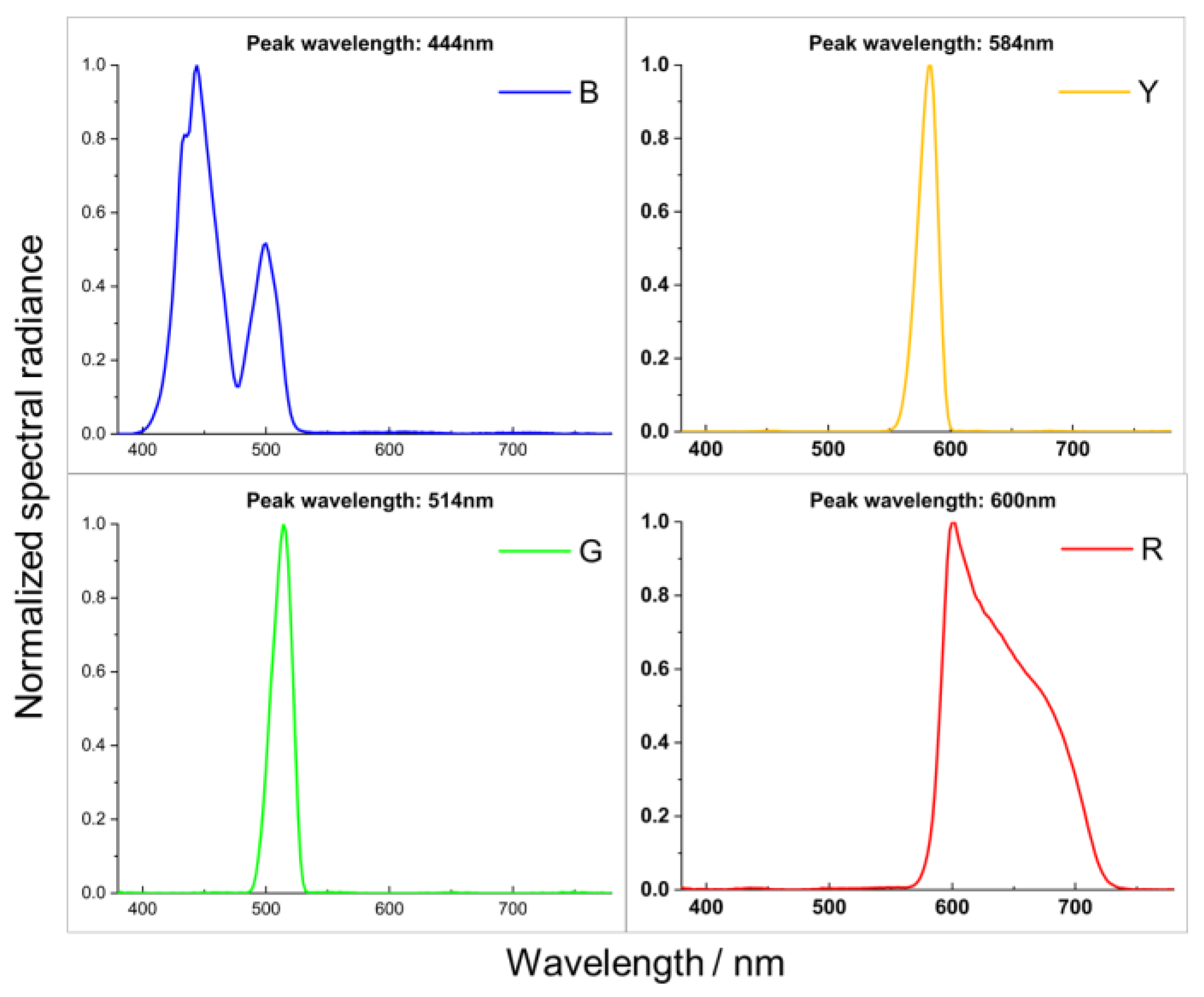
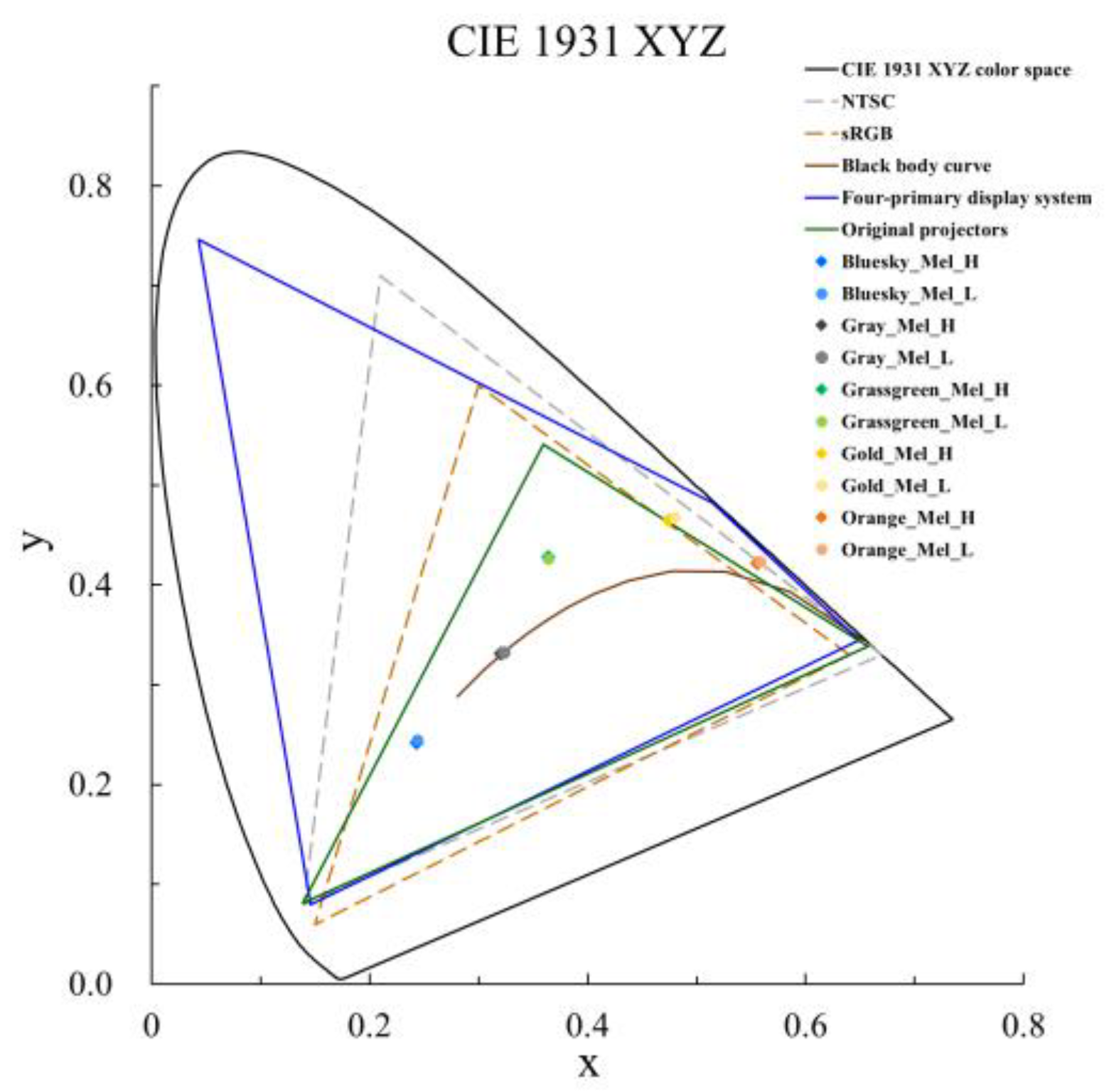
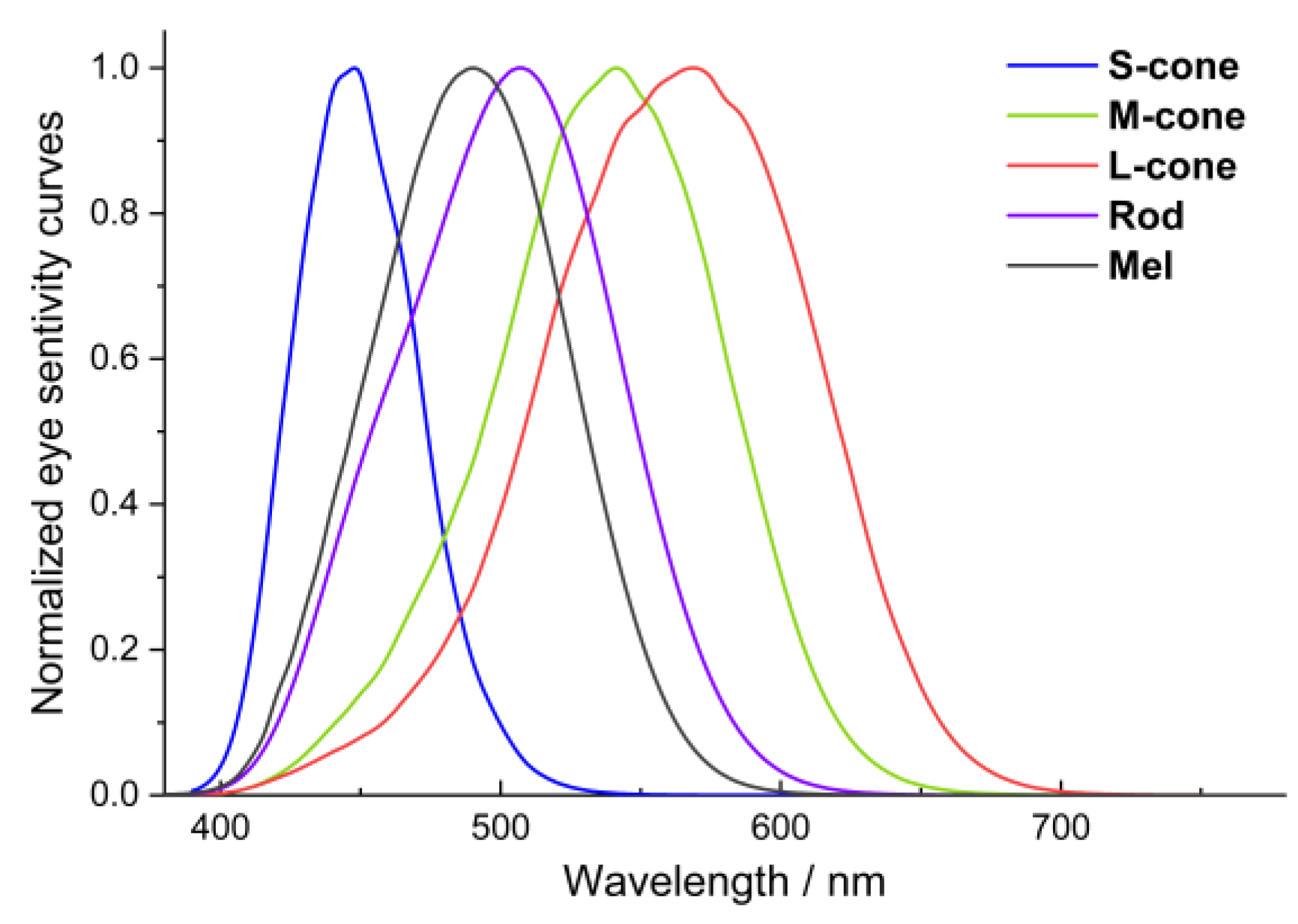

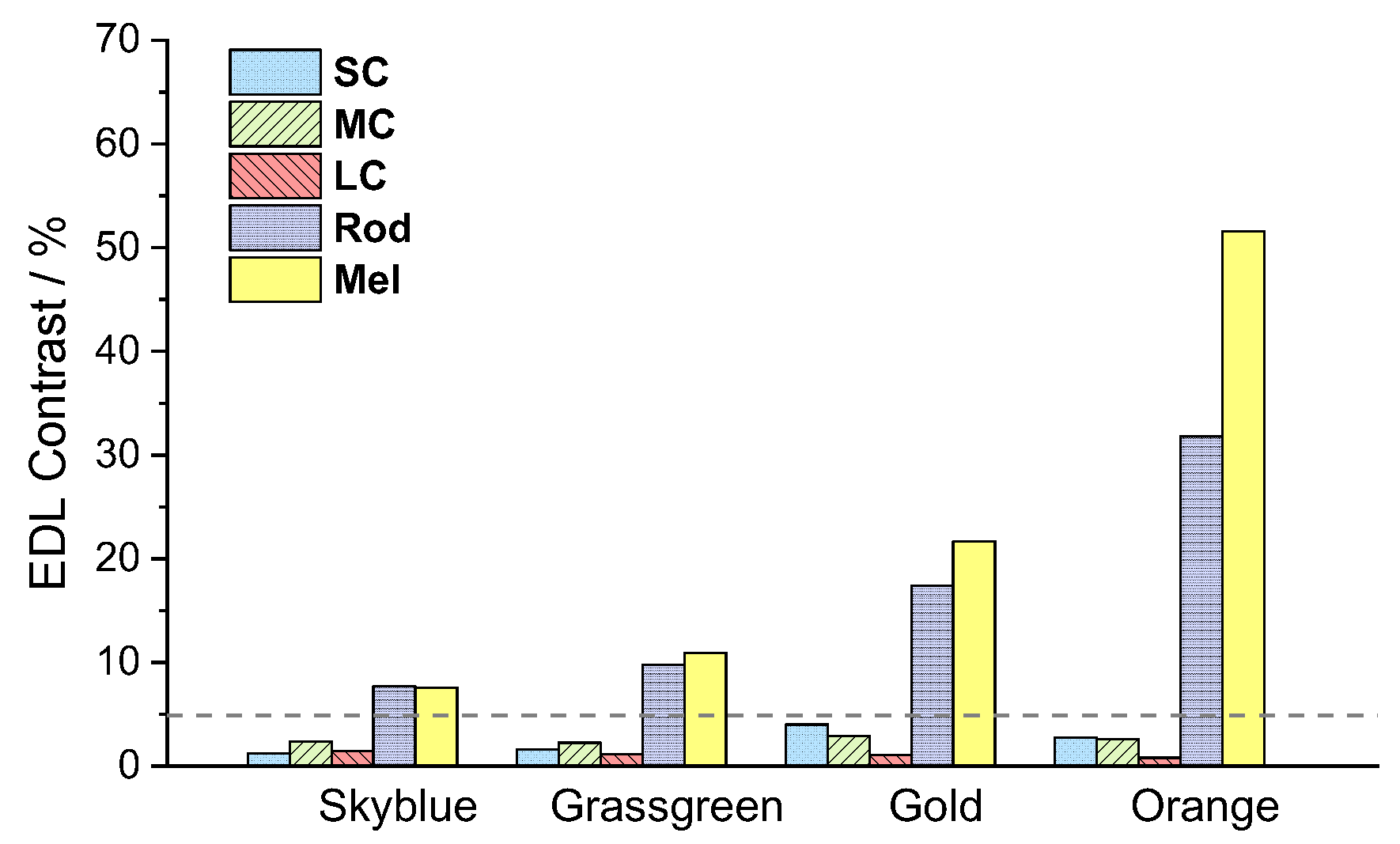




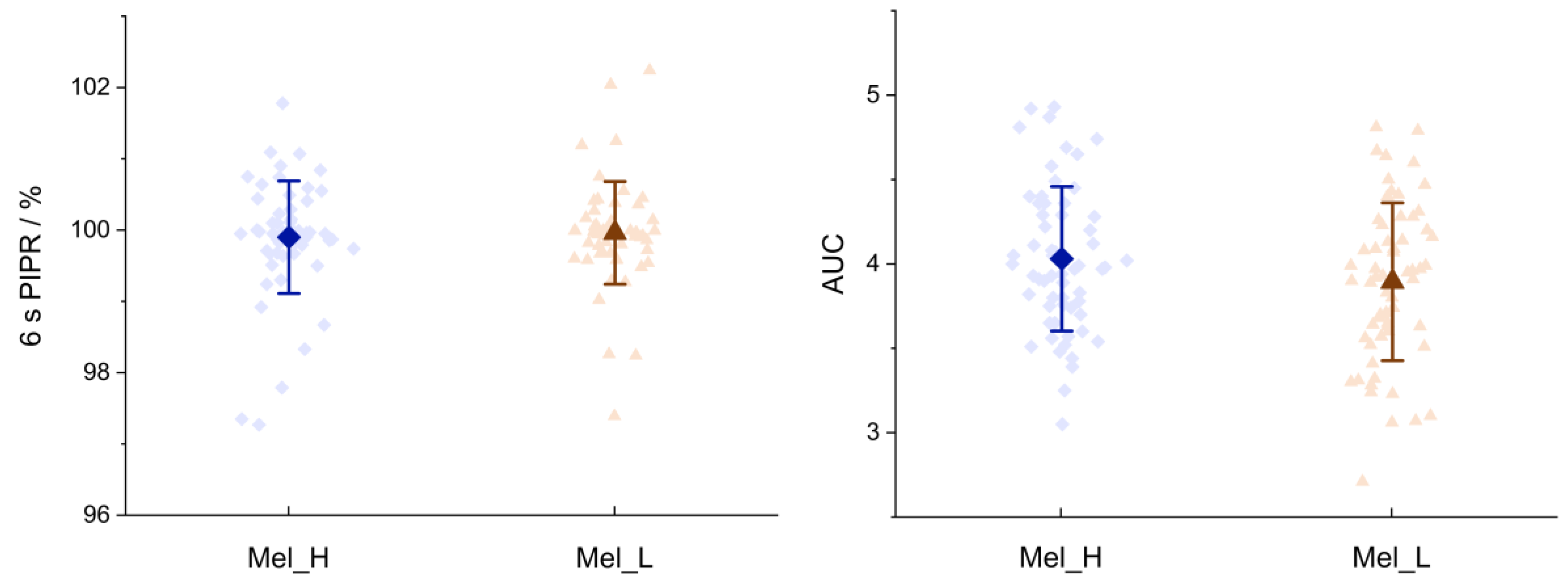
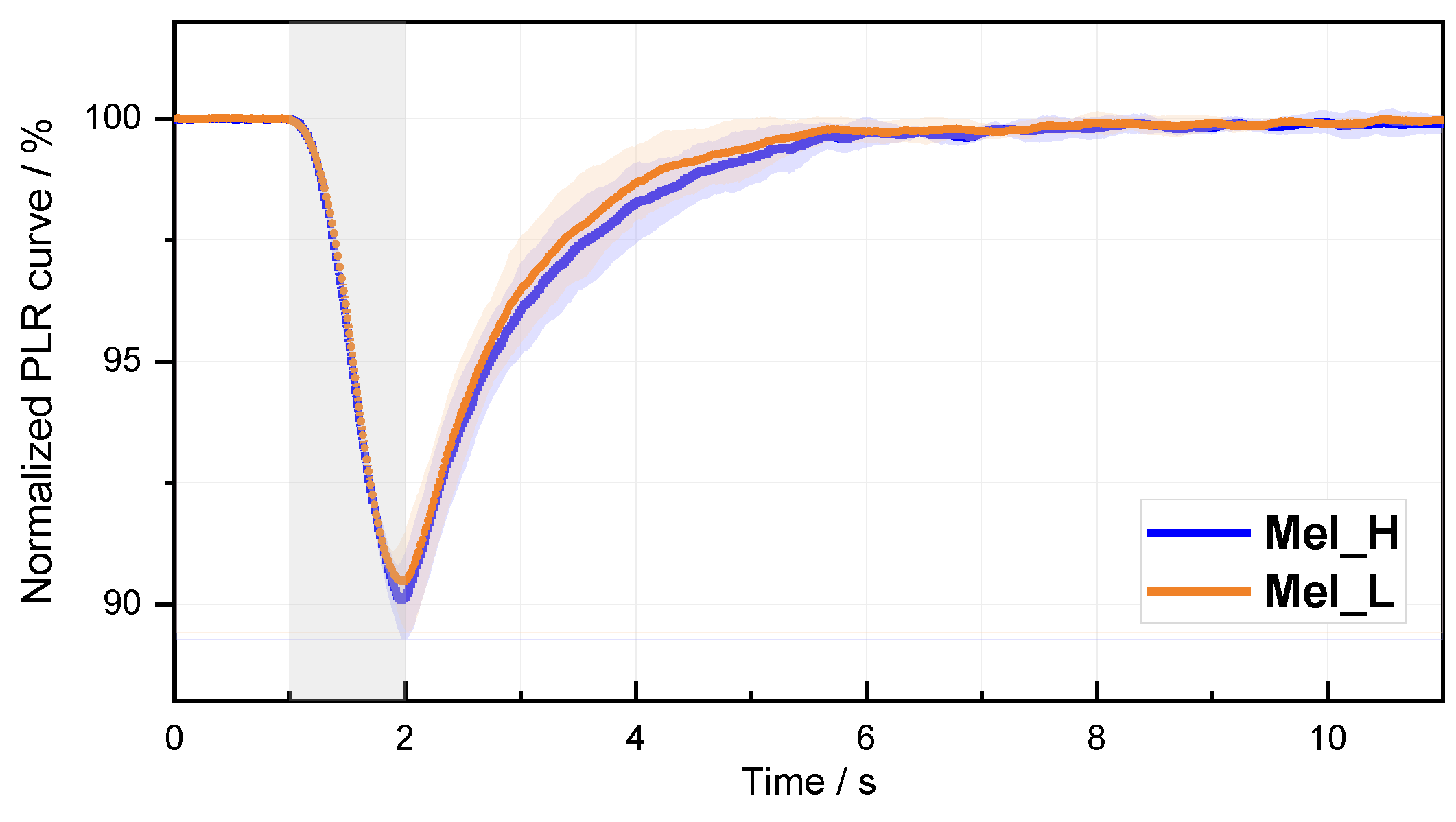
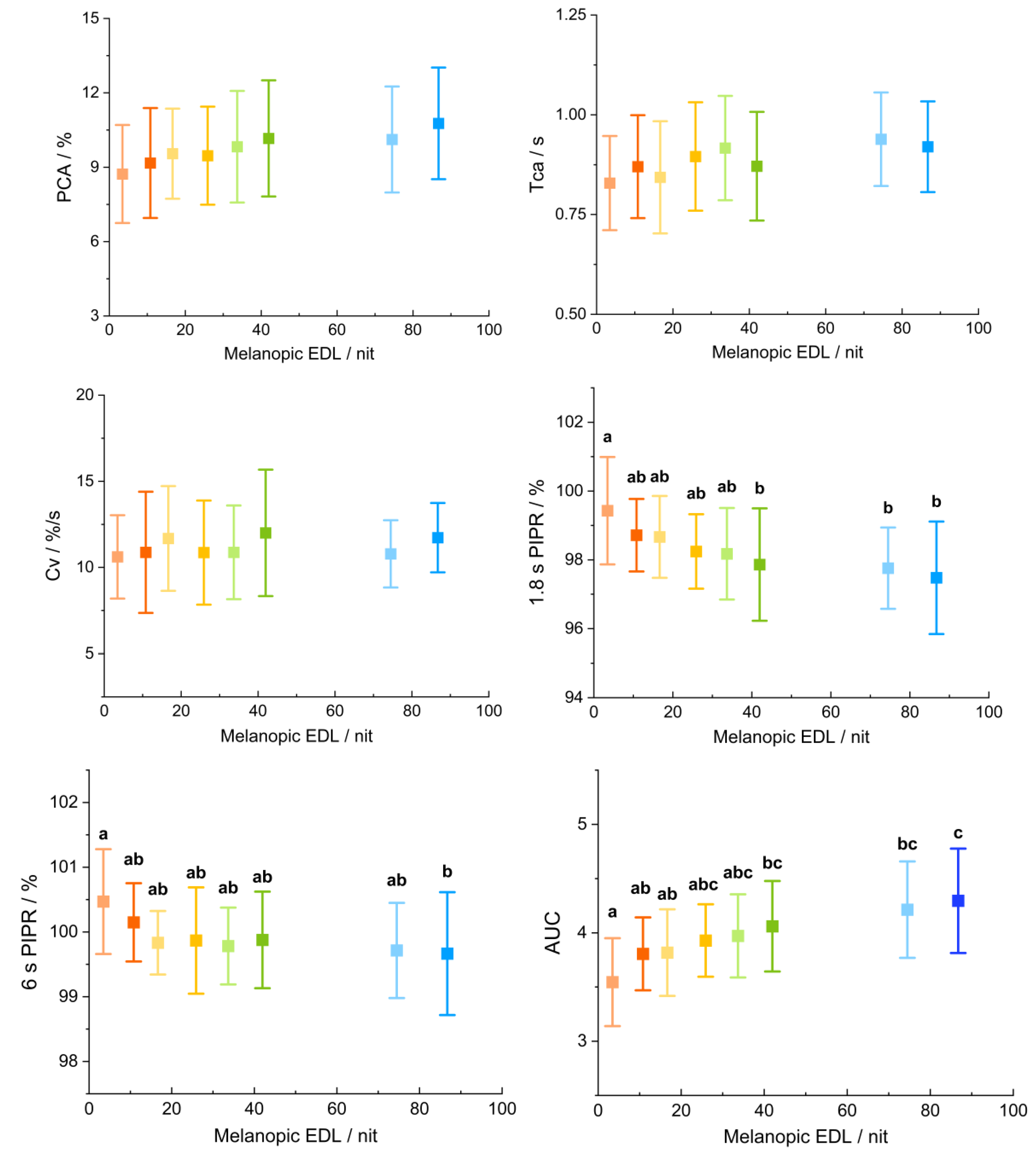


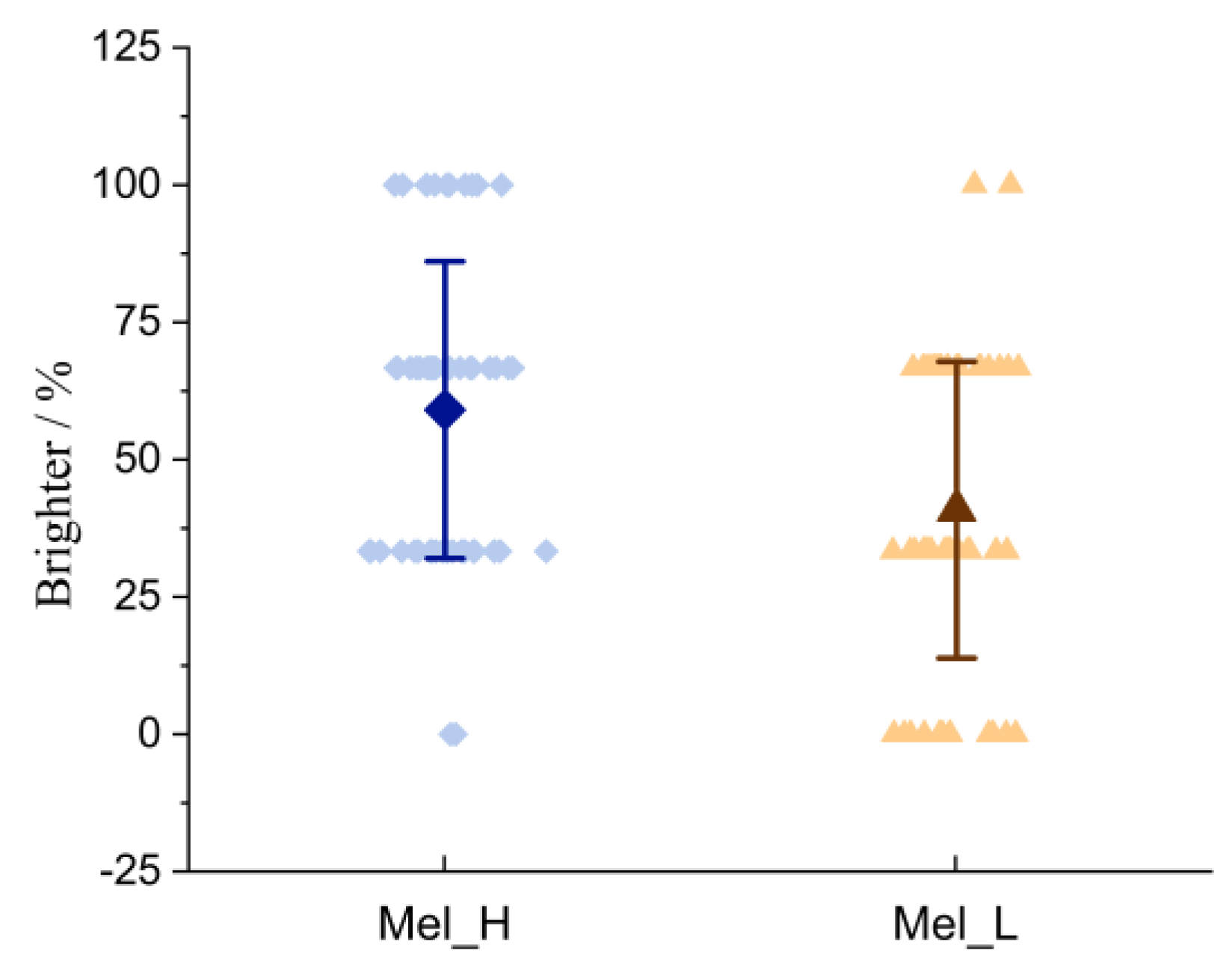
| Colour | MEL-Level | Luminance (Nit) | MC of Luminance (%) | u′ | v′ | Δu′v′ |
|---|---|---|---|---|---|---|
| Skyblue | Mel_H | 50.28 | 0.54 | 0.1799 | 0.4018 | 0.0030 |
| Mel_L | 49.74 | 0.1787 | 0.4046 | |||
| Grassgreen | Mel_H | 50.00 | 0.55 | 0.1965 | 0.5198 | 0.0009 |
| Mel_L | 49.45 | 0.1972 | 0.5192 | |||
| Gold | Mel_H | 50.01 | 0.48 | 0.2486 | 0.5484 | 0.0028 |
| Mel_L | 49.53 | 0.2508 | 0.5502 | |||
| Orange | Mel_H | 50.13 | 0.29 | 0.3198 | 0.5462 | 0.0012 |
| Mel_L | 49.84 | 0.3205 | 0.5472 |
| Colour | MEL-Level | S-Cone | M-Cone | L-Cone | Rod | Mel | |||||
|---|---|---|---|---|---|---|---|---|---|---|---|
| EDL | MC | EDL | MC | EDL | MC | EDL | MC | EDL | MC | ||
| Skyblue | Mel_H | 99.10 | 1.24 | 59.90 | 2.38 | 52.50 | 1.46 | 80.90 | 7.71 | 86.72 | 7.59 |
| Mel_L | 96.68 | 57.11 | 50.98 | 69.32 | 74.48 | ||||||
| Grassgreen | Mel_H | 20.83 | 1.62 | 48.79 | 2.26 | 50.16 | 1.17 | 45.26 | 9.81 | 41.96 | 10.93 |
| Mel_L | 21.51 | 46.63 | 49.00 | 37.17 | 33.69 | ||||||
| Gold | Mel_H | 4.48 | 4.02 | 41.49 | 2.89 | 51.24 | 1.07 | 30.51 | 17.42 | 25.90 | 21.69 |
| Mel_L | 4.13 | 39.16 | 50.15 | 21.45 | 16.67 | ||||||
| Orange | Mel_H | 1.82 | 2.75 | 32.98 | 2.61 | 53.34 | 0.81 | 14.72 | 31.81 | 10.79 | 51.58 |
| Mel_L | 1.92 | 31.31 | 52.48 | 7.62 | 3.45 | ||||||
| Dependent Variable | F | Sig. | |
|---|---|---|---|
| PCA | 1.049 | 0.310 | 0.017 |
| Tca | 0.113 | 0.738 | 0.002 |
| Cv | 0.688 | 0.410 | 0.012 |
| 1.8 s PIPR | 4.069 | 0.048 | 0.065 |
| 6 s PIPR | 0.251 | 0.619 | 0.004 |
| AUC | 3.551 | 0.064 | 0.057 |
| Dependent Variable | F | Sig. | |
|---|---|---|---|
| PCA | 1.823 | 0.123 | 0.115 |
| Tca | 1.481 | 0.183 | 0.096 |
| Cv | 0.608 | 0.748 | 0.042 |
| 1.8 s PIPR | 3.563 | 0.002 | 0.203 |
| 6 s PIPR | 2.248 | 0.063 | 0.138 |
| AUC | 5.466 | <0.001 | 0.281 |
| PLR Parameters | R2 | a | b |
|---|---|---|---|
| 1.8 s PIPR | 0.977 | −1.347 | 100 |
| 6 s PIPR | 0.883 | −0.540 | 101 |
| AUC | 0.969 | 0.513 | 3.24 |
| Melanopic EDL | 1.8 s PIPR | 6 s PIPR | AUC | |
|---|---|---|---|---|
| Melanopic EDL | 1 | −0.368 ** | −0.247 ** | 0.466 ** |
| 1.8 s PIPR | −0.368 ** | 1 | 0.192 * | −0.198 * |
| 6 s PIPR | −0.247 ** | 0. 192 * | 1 | −0.352 ** |
| AUC | 0.466 ** | −0.198 * | −0.352 ** | 1 |
Disclaimer/Publisher’s Note: The statements, opinions and data contained in all publications are solely those of the individual author(s) and contributor(s) and not of MDPI and/or the editor(s). MDPI and/or the editor(s) disclaim responsibility for any injury to people or property resulting from any ideas, methods, instructions or products referred to in the content. |
© 2025 by the authors. Licensee MDPI, Basel, Switzerland. This article is an open access article distributed under the terms and conditions of the Creative Commons Attribution (CC BY) license (https://creativecommons.org/licenses/by/4.0/).
Share and Cite
Zhu, N.; Tu, Y.; Wang, L.; Shi, Y. Melanopsin Contribution to Pupillary Light Reflex and Brightness Perception Based on a 65-Inch Four-Primary Projected Display. Photonics 2025, 12, 88. https://doi.org/10.3390/photonics12010088
Zhu N, Tu Y, Wang L, Shi Y. Melanopsin Contribution to Pupillary Light Reflex and Brightness Perception Based on a 65-Inch Four-Primary Projected Display. Photonics. 2025; 12(1):88. https://doi.org/10.3390/photonics12010088
Chicago/Turabian StyleZhu, Nianfang, Yan Tu, Lili Wang, and Yunyang Shi. 2025. "Melanopsin Contribution to Pupillary Light Reflex and Brightness Perception Based on a 65-Inch Four-Primary Projected Display" Photonics 12, no. 1: 88. https://doi.org/10.3390/photonics12010088
APA StyleZhu, N., Tu, Y., Wang, L., & Shi, Y. (2025). Melanopsin Contribution to Pupillary Light Reflex and Brightness Perception Based on a 65-Inch Four-Primary Projected Display. Photonics, 12(1), 88. https://doi.org/10.3390/photonics12010088





